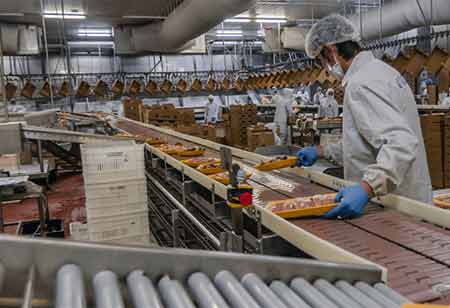Thank you for Subscribing to Food Business Review Weekly Brief
- Home
- Topics
- Alternative Proteins and Plant Based Food
- Beer and Wine
- Canned Beverages
- Coffee And Tea
- Food and Beverage Consulting
- Food and Beverage Financial Service
- Food And Beverages Marketing
- Food Distributors
- Food Ingredients
- Food Sustainability
- Plant Based Food and Beverages
- Seafood Suppliers
- Supplement Manufacturing
- Wine Investment
- News
- Vendor Viewpoint
- CXO Insights
- Conferences
- Newsletter
- CXO Awards
-
The Food Processing Industry Development From Iot
The latest applications leveraging IoT technologies have presented promising features for food safety and processing facilities. With such established technologies

By
Food Business Review | Tuesday, February 01, 2022
Stay ahead of the industry with exclusive feature stories on the top companies, expert insights and the latest news delivered straight to your inbox. Subscribe today.

IoT devices can cover various operational and quality-control methods for the food processor, the volume of food items processed, their temperature, pressure levels, and the labels.
FREMONT, CA: The latest applications leveraging IoT technologies have presented promising features for food safety and processing facilities. With such established technologies, the industry can trace the products along the supply chain to use the sensors to monitor the condition of food and give warnings about the food safety risks.
IoT-enabled Wearables:
Multiple employees manage the food item before the packaging and during and after processing, which might have been in contact with raw foodstuffs, resulting in potential contaminants. Therefore, any form of hygiene issue needs to be dealt with instantly to avoid contamination of food items, recalls, loss of revenue, and harm to brand reputation.
With IoT-enabled technologies in wearables and healthcare systems, employee health can be tracked and monitored. It permits the employees to monitor their health and share confirmed data with the company to become completely qualified for the work without any remains of viruses or bacteria.
Check Out This: Top Hearing Aids Companies ( Lucid Hearing )
The food and beverage factories have established body temperature-monitoring technologies combined with facial recognition and other biometric identification that help them automatically identify the indicators of illness like high temperature.
Furthermore, the IoT-enabled wearables like smartwatches, bright gloves, and smart glasses have augmented reality instilled in them, allowing them to help in the food processing industry and improve work processes, productivity, and food safety.
Nevertheless, for prosperous working and adaptation of these technologies, the potential problems concerning data privacy, employee motivation, and security must be tackled first. Data gathered from IoT devices might be sensitive and require treatment with the highest discretion.
Hyperspectral Imaging:
Several food scandals have floated up due to illegal or unsuitable ingredients in food products purchased by consumers. For example, false meat caused a massive wipeout for the retailers, which could have been prevented by not diluting the meat products identified in the food supply chain earlier.
The food negligence and contamination can be maintained by the Food Standards Agencies of the respective countries that will study the samples of meat products before they reach the marketplace from the labs. It has driven the supermarkets to monitor their supply chains to avoid repeating the incidents cautiously. The events also modified the food habits of the customers.
The latest broad-spectrum imaging technology, known as hyperspectral imaging, has helped the industry by permitting the food processors to continually look after different food elements available on the production line. Hyperspectral imaging can be set to determine a specific spectrum of light released by chemical and biological components present in the product, making it an influencing tool for food safety. Combined with an IoT system, it offers an immediate alert throughout the entire network, followed by rapid response along the supply chain and the food safety authorities.
Different sectors have leveraged hyperspectral imaging technology for years now, such as mining, agriculture, biotechnology, environmental monitoring, and the armed forces. In addition, it has also been utilized in the food analysis features recently, keeping in mind the demanding need for rapid evaluation and the requirement for data handling generated in vast numbers.
Tracking Contamination:
Several sensor varieties are leveraged in the IoT systems to monitor food safety in fields and during transportation with the appropriate temperature, humidity, and heavy metal and give warnings if there are any food hazards or residues of contamination.
Food items that carry any unusual environmental contamination can be instantly identified while handling them on-site or during other processes. Later, they can be treated following the processing line before influencing a much larger volume of food or harming the customer.






